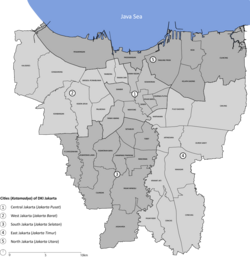 The façade of Pasar Senen Station, taken on 16 October 2020. | |||||||||||
| General information | |||||||||||
| Location | Jl. Stasiun Senen No. 14, Senen, Senen, Central Jakarta Jakarta Indonesia | ||||||||||
| Coordinates | 6°10′28″S106°50′40″E / 6.17444°S 106.84444°E | ||||||||||
| Elevation | +4.7 m (15 ft) | ||||||||||
| System | Inter-city rail and commuter rail station | ||||||||||
| Owned by | Kereta Api Indonesia | ||||||||||
| Operated by | Kereta Api Indonesia KAI Commuter | ||||||||||
| Lines | |||||||||||
| Platforms | 1 island platform 2 side platforms | ||||||||||
| Tracks | 6 | ||||||||||
| Connections | | ||||||||||
| Construction | |||||||||||
| Parking | | ||||||||||
| Bicycle facilities | | ||||||||||
| Accessible | | ||||||||||
| Architect | J. van Gendt | ||||||||||
| Architectural style | New Indies | ||||||||||
| Other information | |||||||||||
| Station code | PSE • 0470 [1] | ||||||||||
| Classification | Large type A [1] | ||||||||||
| History | |||||||||||
| Opened | 1887 | ||||||||||
| Rebuilt | 1925 | ||||||||||
| Electrified | 1924 | ||||||||||
| Services | |||||||||||
| |||||||||||
| |||||||||||
Pasar Senen Station (PSE) [1] is a railway station located in Jakarta, Indonesia. It is the second largest railway station in Jakarta after Gambir Station. It is located close to Pasar Senen market area in Senen, Senen, Central Jakarta. The current building was built in 1918 and inaugurated on 19 March 1925.
Contents
- History
- Background
- First generation (1887–1925)
- Second generation (1925–now)
- Building and layout
- Main building
- Tekad Merdeka Monument
- Services
- Mixed Class
- Full Economy Class
- Fully Subsidized Economy Class
- KAI Commuter
- Supporting transportation
- Gallery
- References
- Cited works
- External links
Pasar Senen only serves Economy and Business class intercity train except Gumarang and Sawunggalih. It also serves as a station for northbound KRL Commuterline trains.









